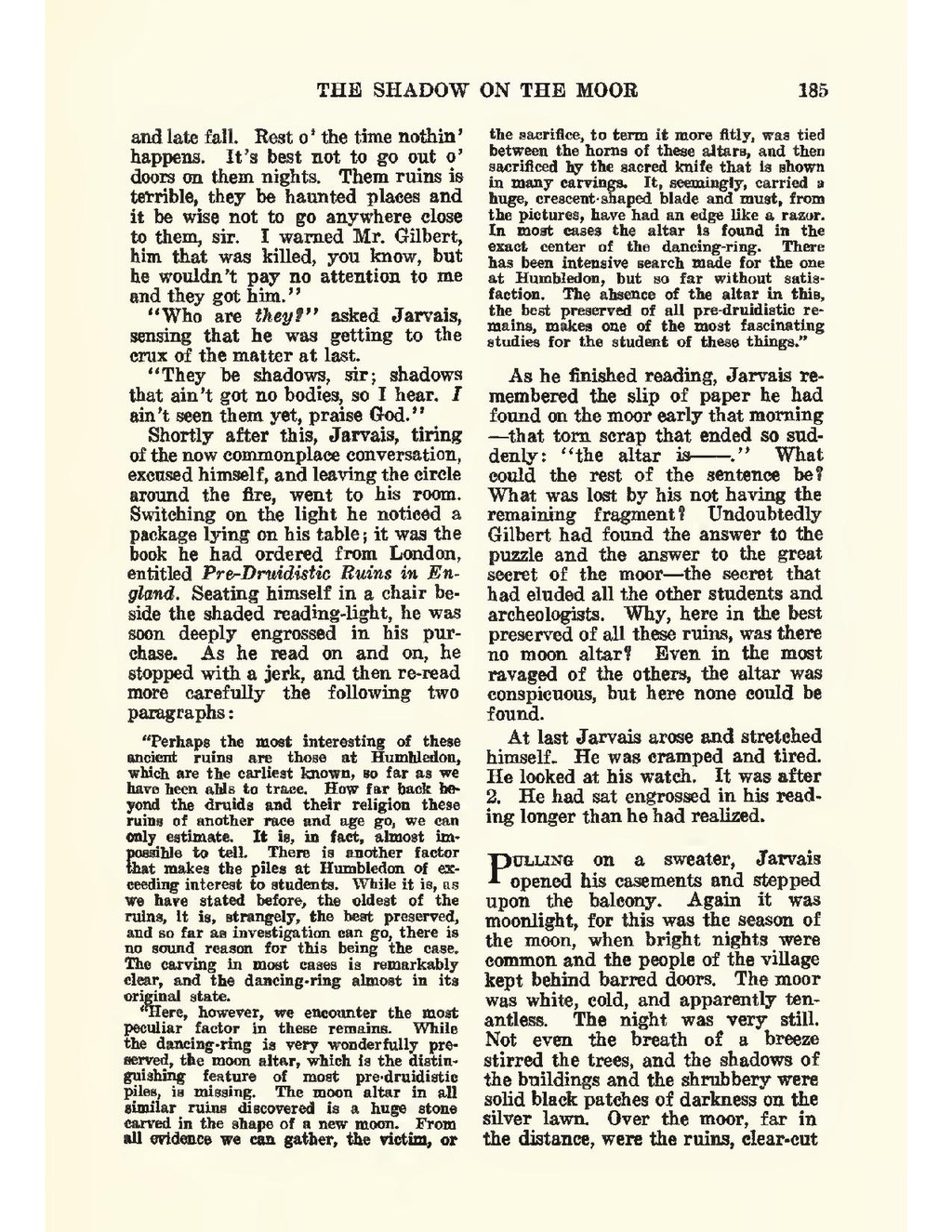and late fall. Rest o’ the time nothin’ happens. It’s best not to go out o’ doors on them nights. Them ruins is terrible, they be haunted places and it be wise not to go anywhere close to them, sir. I warned Mr. Gilbert, him that was killed, you know, but he wouldn’t pay no attention to me and they got him.”
“Who are they?” asked Jarvais, sensing that he was getting to the crux of the matter at last.
“They be shadows, sir; shadows that ain’t got no bodies, so I hear. I ain’t seen them yet, praise God.”
Shortly after this, Jarvais, tiring of the now commonplace conversation, excused himself, and leaving the circle around the fire, went to his room. Switching on the light he noticed a package lying on his table; it was the book he had ordered from London, entitled Pre-Druidistic Ruins in England. Seating himself in a chair beside the shaded reading-light, he was soon deeply engrossed in his purchase. As he read on and on, he stopped with a jerk, and then re-read more carefully the following two paragraphs:
“Perhaps the most interesting of these ancient ruins are those at Humbledon, which are the earliest known, as far as we have been able to trace. How far back beyond the druids and their religion these ruins of another race and age go, we can only estimate. It is, in fact, almost impossible to tell. There is another factor that makes the piles at Humbledon of exceeding interest to students. While it is, as we have stated before, the oldest of the ruins, it is, strangely, the best preserved, and so far as investigation can go, there is no sound reason for this being the case. The carving in most cases is remarkably clear, and the dancing-ring almost in its original state.
“Here, however, we encounter the most peculiar factor in these remains. While the dancing-ring is very wonderfully preserved, the moon altar, which is the distinguishing feature of most pre-druidistic piles, is missing. The moon altar in all similar ruins discovered is a huge stone carved in the shape of a new moon. From all evidence we can gather, the victim, or the sacrifice, to term it more fitly, was tied between the horns of these altars, and then sacrificed by the sacred knife that is shown in many carvings. It seemingly carried a huge, crescent-shaped blade and must, from the pictures, have had an edge like a razor. In most cases the altar is found in the exact center of the dancing-ring. There has been intensive search made for the one at Humbledon, but so far without satisfaction. The absence of the altar in this, the best preserved of all pre-druidistic remains, makes one of the most fascinating studies for the student of these things.”
As he finished reading, Jarvais remembered the slip of paper he had found on the moor early that morning —that tom scrap that ended so suddenly: “the altar is-.” What could the rest of the sentence be? What was lost by his not having the remaining fragment? Undoubtedly Gilbert had found the answer to the puzzle and the answer to the great secret of the moor—the secret that had eluded all the other students and archeologists. Why, here in the best preserved of all these ruins, was there no moon altar? Even in the most ravaged of the others, the altar was conspicuous, but here none could be found.
At last Jarvais arose and stretched himself. He was cramped and tired. He looked at his watch. It was after 2. He had sat engrossed in his reading longer than he had realized.
Pulling on a sweater, Jarvais opened his casements and stepped upon the balcony. Again it was moonlight, for this was the season of the moon, when bright nights were common and the people of the village kept behind barred doors. The moor was white, cold, and apparently tenantless. The night was very still. Not even the breath of a breeze stirred the trees, and the shadows of the buildings and the shrubbery were solid black patches of darkness on the silver lawn. Over the moor, far in the distance, were the ruins, clear-cut
